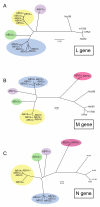Recovery of divergent avian bornaviruses from cases of proventricular dilatation disease: identification of a candidate etiologic agent
- PMID: 18671869
- PMCID: PMC2546392
- DOI: 10.1186/1743-422X-5-88
Recovery of divergent avian bornaviruses from cases of proventricular dilatation disease: identification of a candidate etiologic agent
Abstract
Background: Proventricular dilatation disease (PDD) is a fatal disorder threatening domesticated and wild psittacine birds worldwide. It is characterized by lymphoplasmacytic infiltration of the ganglia of the central and peripheral nervous system, leading to central nervous system disorders as well as disordered enteric motility and associated wasting. For almost 40 years, a viral etiology for PDD has been suspected, but to date no candidate etiologic agent has been reproducibly linked to the disease.
Results: Analysis of 2 PDD case-control series collected independently on different continents using a pan-viral microarray revealed a bornavirus hybridization signature in 62.5% of the PDD cases (5/8) and none of the controls (0/8). Ultra high throughput sequencing was utilized to recover the complete viral genome sequence from one of the virus-positive PDD cases. This revealed a bornavirus-like genome organization for this agent with a high degree of sequence divergence from all prior bornavirus isolates. We propose the name avian bornavirus (ABV) for this agent. Further specific ABV PCR analysis of an additional set of independently collected PDD cases and controls yielded a significant difference in ABV detection rate among PDD cases (71%, n = 7) compared to controls (0%, n = 14) (P = 0.01; Fisher's Exact Test). Partial sequence analysis of a total of 16 ABV isolates we have now recovered from these and an additional set of cases reveals at least 5 distinct ABV genetic subgroups.
Conclusion: These studies clearly demonstrate the existence of an avian reservoir of remarkably diverse bornaviruses and provide a compelling candidate in the search for an etiologic agent of PDD.
Figures



References
-
- Daoust PY, Julian RJ, Yason CV, Artsob H. Proventricular impaction associated with nonsuppurative encephalomyelitis and ganglioneuritis in two Canada geese. J Wildl Dis. 1991;27:513–517. - PubMed
-
- Gregory C, Latimer KS, Niagro F, Ritchie BW, Campagnoli RP, Norton TM, Greenacre CB. A review of proventricular dilatation syndrome. J Assoc Avian Vet. 1994;8:69–75.
Publication types
MeSH terms
Grants and funding
LinkOut - more resources
Full Text Sources
Other Literature Sources
Medical

